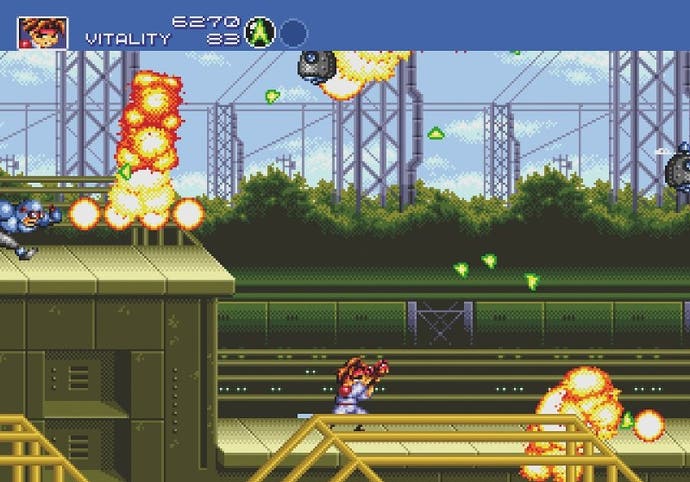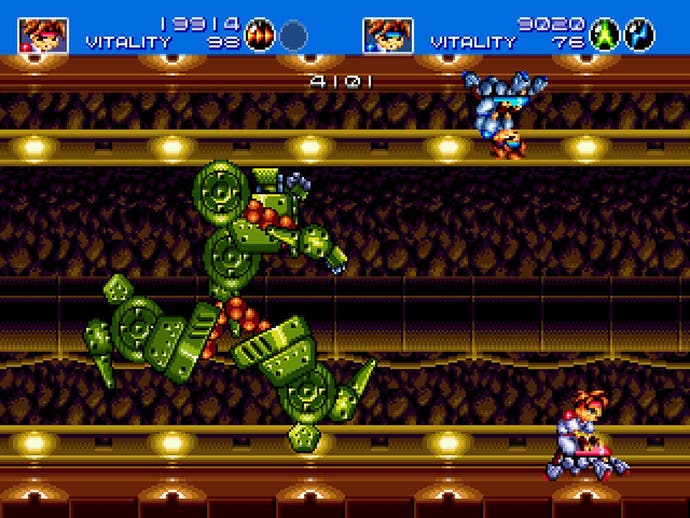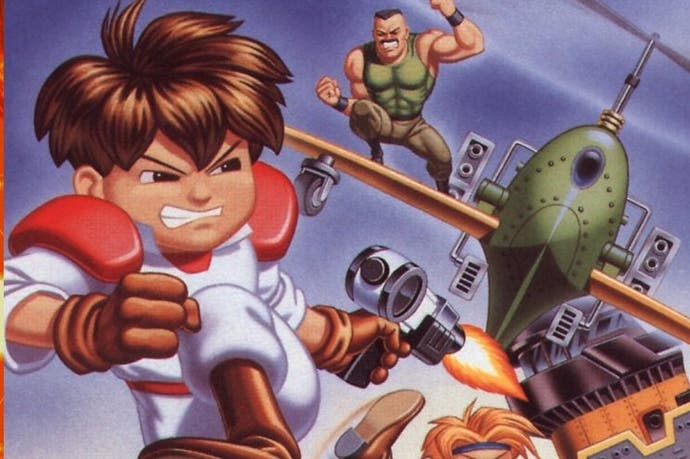Gunstar Heroes' 3DS outing is another triumph for M2
Treasure piece.
Well over two decades since it first came out, Gunstar Heroes still has the ability to surprise. Even if, like me, you've been returning to it on an annual basis ever since, the 60 minutes it takes for a play through are so dense with ideas you'll still find some new detail, or some new piece of throwaway comedy: a foot soldier hiding under an oil barrel and scurrying away from the fray; a downed boss tossing you the gem you covet in his death throes, only for it to explode and chip away your health in a cruel piece of slapstick. It's one of those perfect video games, impervious to the passage of time.
M2's sublime handling of the 1993 Mega Drive original for the 3DS is now easily the best way to play Treasure's shooter - which isn't itself much of a surprise, if you've been following M2's excellent work with 3D Classics on Nintendo's handheld. It's a Criterion Collection for Sega's brightest and best, restoring classics such as OutRun and Afterburner 2 with emulations that are as good as you could hope, complete with nerdish, completist options that were never there before (if you care about the difference between sound processors on the two iterations of Mega Drive hardware then boy are you in for a treat). They've easy claim to being the definitive versions of the games they feature.
There's something special about this one, though. Part of it's the wonderful symmetry - early on in M2's history it created another handheld take on Gunstar Heroes, performing the seemingly impossible task of porting the game to Sega's underpowered Game Gear - and part of it's the affinity the studio clearly has with the source material. This is a restoration as well as a meaningful remix, and it's one that sings with passion and care.

The vanilla game plays well - and if you want an approximation of the original experience you can use the 3DS' stereoscopic 3D display to simulate the fuzziness and curve of a CRT display - but it comes alive when played with that depth added to the parallax world, revealing a game that seems to have been built back in the day with 3D in mind. From the Treasure logo unfolding on the start screen to the crude boxes that make up boss Bravoo Man, it's incredible how snug a fit Gunstar Heroes is on the 3DS.
It only helps bring into focus the original Gunstar Heroes, making sure the kinetic chaos that's at the heart of this shooter remains as sharp as ever. For all of its detail in design - this is a game that's overflowing with ideas, never repeating a trick right up to the very end - it can be a remarkably messy game, a sense of noisy impact as the screen fills up with marshmallow explosions and tossed enemies. So much of that's about the arsenal at your disposal, your own alchemy of firepower that allows you to conjure up new, delicious ways to deal out death.
The two weapon slot in Gunstar Heroes is one of its many ideas that would crop up, in some way, later on - Halo: Combat Evolved's enforced minimalism when it comes to loud-outs always felt, to me, to owe some debt - but it's got a Treasure twist that's never really been equalled. While you have one core weapon, the second slot acts as a modifier, opening up some joyous combinations: lasers that dart across the screen; firebombs that pop open in a hot spiral after a short distance; stars that glitter from your gun, seeking out your foes.
One of the fundamental changes made in M2's port - though, it's worth pointing out, it's just an optional extra - is a Gunslinger mode that mixes with that alchemy. Or, rather, it frees it up - rather than being tied to the same core weapon throughout a playthrough, using pick-ups on the fly to modify its behaviour, you're now free to mix and match all of Gunstar Heroes' options as you go, cycling through weapon types to use any combination how and when you please. It's a maximalist solution in a game that's so often about throwing all it can your way, so there's no doubt that it fits - I just sometimes feel that it's not quite as elegant as what's gone before, even if it's an entertaining way to turn up the volume on what's already a noisy game.

It goes to show, too, that Gunstar Heroes can't really be bettered, or improved upon. Treasure's first game remains arguably its best, though that's not to detract from everything that came in its wake - Radiant Silvergun, Sin & Punishment and Bangai-O are all out-and-out classics. It's just that there's something unique and something truly special about the studio's debut, and while that magic flowed throughout its successors it's never quite been as strong. Even Treasure itself couldn't quite be the measure of its 1993 self when it tried: Alien Soldier, which followed immediately afterwards, filtered the side-on shooting into a lurid boss rush that's brilliantly insane, but not quite as intoxicating. Meanwhile Gunstar Super Heroes, the Game Boy Advance sequel that came out in 2005, felt too often like a pale retread.
Treasure, of course, has been largely silent in recent years, its last western release a handful of Xbox Live Arcade remasters of some of its older classics before it retreated to the Japanese market for the 3DS Gaist Crusher games. I still hold out hope that they'll return, someday, for no matter what form they're on the games industry is a sadder, less interesting place for their absence.
But maybe it's not the return of Treasure I should be pining for, and rather the resurgence of its good friends at M2 I should be celebrating. Its original work outside of its exemplary ports rarely finds its way outside of Japan, though I'm hopeful that one its next projects will. Last year, Hiroshi Iuchi - a name synonymous with Treasure thanks to his work directing Radiant Silvergun and Ikaruga - has joined M2, and is working on a new shooter for PlayStation 4 currently dubbed Ubusana. Now that's worth getting excited about.

